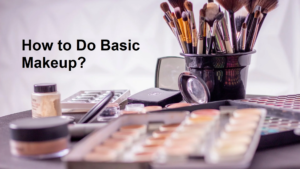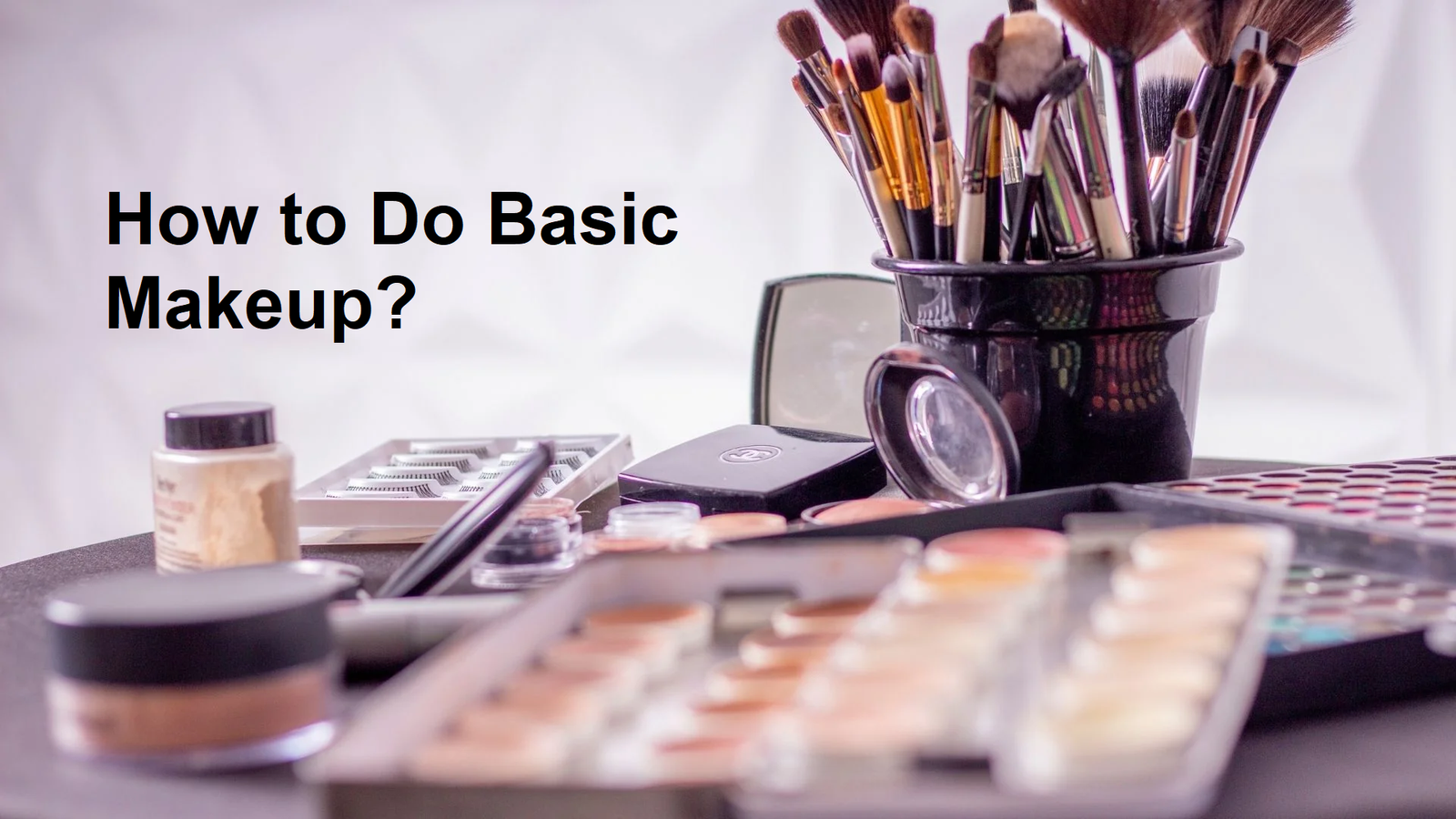Learn the essentials of basic makeup with our comprehensive guide for beginners. From selecting the right tools and products to mastering foundation, concealer, and eye makeup, this guide provides step-by-step instructions to help you build a solid foundation in makeup application. Enhance your natural features, boost your confidence, and explore creative expression with easy-to-follow tips and techniques. How to do basic makeup for beginners? Makeup serves as a versatile tool that can enhance one’s natural features, boost confidence, and allow for creative expression. For beginners, understanding how to do basic makeup is crucial as it lays the groundwork for more advanced techniques. The simplicity of basic makeup ensures that it can be mastered without feeling overwhelming, providing an excellent starting point for those new to the world of cosmetics.

At its core, makeup is about highlighting the best aspects of your face while subtly concealing any imperfections. This balance helps create a polished and natural look that can be adjusted for various occasions. Starting with basic makeup techniques allows beginners to become comfortable with products and tools, gradually building their skills and confidence.
Furthermore, makeup can significantly enhance self-esteem. The act of applying makeup and the resulting look can make a person feel more attractive and ready to tackle the day. This boost in confidence often translates to other areas of life, reinforcing the value of learning these basic skills.
Beyond personal benefits, makeup also offers a creative outlet. It provides the opportunity to experiment with different styles and colors, enabling individuals to express their unique personalities. As beginners become more adept at applying basic makeup, they can explore more intricate looks and trends, further expanding their creative horizons.
This guide is specifically designed to help newcomers build a solid foundation in makeup application. By focusing on essential techniques and products, it aims to make the learning process straightforward and enjoyable. Whether you are looking to enhance your daily routine or prepare for special events, mastering basic makeup is the first step towards achieving your desired look.
Essential Tools and Products for basic makeup
Embarking on the journey of learning how to do basic makeup for beginners requires the right tools and products in your makeup kit. A well-rounded kit should include foundation, concealer, powder, blush, eyeshadow, eyeliner, mascara, lipstick, and a variety of brushes. Understanding the purpose of each item and selecting the right ones can make the process easier and more enjoyable.
- Foundation: Foundation serves as the base for your makeup, providing an even skin tone and a smooth canvas. Choose a foundation that matches your skin type and tone; for instance, a matte foundation for oily skin or a hydrating one for dry skin.
- Concealer: Concealer is essential for hiding blemishes, dark circles, and other imperfections. Opt for a concealer that is one shade lighter than your foundation to brighten the under-eye area and effectively cover spots.
- Powder: Setting powder helps to set your foundation and concealer, reducing shine and ensuring longevity. Translucent powders work for most skin tones, but tinted powders can offer additional coverage.
- Blush: Blush adds a healthy flush to your cheeks, giving you a youthful and vibrant look. Powder blush is ideal for oily skin, while cream blush works well for dry skin. Choose a shade that complements your skin tone for a natural finish.
- Eyeshadow: Eyeshadow can enhance your eyes and add depth to your look. Start with a basic palette containing neutral shades, which are versatile and suitable for various occasions.
- Eyeliner: Eyeliner defines your eyes, making them appear larger and more prominent. Beginners may find pencil or gel eyeliners easier to control than liquid ones.
- Mascara: Mascara lengthens and volumizes your lashes, completing your eye makeup. Waterproof mascaras are long-lasting but can be harder to remove, so choose based on your needs and preferences.
- Lipstick: Lipstick adds color and dimension to your lips. Beginners should start with versatile shades like nude, pink, or red. Consider your skin undertone when selecting the perfect shade.
- Brushes: Quality brushes are crucial for applying makeup evenly and effectively. Essential brushes include a foundation brush, concealer brush, powder brush, blush brush, eyeshadow brush, and a blending brush. Investing in good brushes can make a significant difference in your makeup application.
When building your beginner’s makeup kit, consider your skin type, tone, and budget. Select products that work well for your specific needs and preferences. With the right tools and products, you’ll be well-prepared to master the basics of makeup application.
Preparing Your Skin to do makeup
Before delving into the artistry of makeup application, it is crucial to emphasize the importance of skincare. Properly preparing your skin forms the foundation for a flawless makeup look and ensures that makeup lasts longer. Understanding how to do basic makeup for beginners starts with a solid skincare routine.
The first step in preparing your skin is cleansing. Cleansing removes impurities, excess oil, and any residual makeup from the skin. It is essential to use a cleanser that is suitable for your skin type—whether oily, dry, combination, or sensitive—to avoid irritation and maintain the skin’s natural balance.
Following cleansing, toning is the next important step. Toners help to restore the skin’s pH balance, tighten pores, and remove any leftover impurities. Opt for an alcohol-free toner to prevent drying out your skin. This step is particularly beneficial for those with oily or acne-prone skin, but it can be advantageous for all skin types.
Moisturizing is the third critical step in the skincare routine. A good moisturizer hydrates the skin, creating a smooth canvas for makeup application. Choose a moisturizer that complements your skin type to ensure optimal hydration without clogging pores. Even those with oily skin should not skip this step, as properly hydrated skin can help control excess oil production.
Finally, applying a primer is a game-changer in makeup preparation. A primer creates a smooth base for makeup, helping it adhere better and last longer throughout the day. Primers come in various formulations, such as mattifying, hydrating, or color-correcting, to cater to different skin needs. Selecting the right primer can significantly improve the overall appearance and longevity of your makeup.
In summary, understanding how to do basic makeup for beginners involves recognizing the essential role of skincare. By cleansing, toning, moisturizing, and using a primer, you lay the groundwork for a successful and enduring makeup application.
Applying Foundation and Concealer
When learning how to do basic makeup for beginners, mastering the application of foundation and concealer is crucial. Foundation provides a uniform base, while concealer targets specific areas to cover imperfections. Understanding the different types of foundations and choosing the right shade for your skin tone are the first steps.
Foundations come in three primary forms: liquid, powder, and cream. Liquid foundation is versatile and suitable for most skin types, offering varying levels of coverage from light to full. Powder foundation is ideal for oily skin as it helps control shine. Cream foundation provides the most coverage and is beneficial for dry or mature skin. To select the right shade, test a small amount of foundation on your jawline or wrist. The correct shade should blend seamlessly with your natural skin color.
To apply foundation evenly, you can use a brush, sponge, or your fingers. Each tool offers a different finish. Brushes, particularly flat or buffing brushes, provide a polished look and are excellent for building coverage. Sponges, especially when dampened, give a more natural and dewy finish. Fingers can be used for a quick application and help warm up the product for better blending.
Begin by applying a small amount of foundation in the center of your face, typically the forehead, nose, cheeks, and chin. Blend outward in circular motions to avoid harsh lines and ensure even coverage. Pay attention to the hairline and jawline to prevent noticeable edges.
Concealer is used to hide blemishes, dark circles, and other imperfections. Choose a concealer that is one to two shades lighter than your foundation for under-eye areas to brighten and lift. For blemishes and redness, use a concealer that matches your foundation. Apply concealer in small dots, then blend using a tapping motion with a brush, sponge, or your fingers. For under-eye circles, apply in a triangular shape for a more natural, lifted look.
Effective application of foundation and concealer can significantly enhance your makeup routine, creating a smooth, flawless base that sets the stage for the rest of your makeup.
Setting Your Base to do makeup
Setting your base is a crucial step in achieving a polished and long-lasting makeup look, especially for beginners. After applying your foundation and concealer, it’s essential to set them with powder to ensure they stay in place throughout the day. There are two main types of powder to consider: setting powder and finishing powder. Setting powder is designed to lock in your foundation and concealer, providing a matte finish and preventing creasing. Finishing powder, on the other hand, is used as a final touch to blur imperfections and give your skin a smooth, airbrushed appearance.
To apply setting powder, use a fluffy powder brush or a damp makeup sponge. Lightly dip your brush or sponge into the powder, then tap off any excess to avoid over-application. Gently press the powder onto your skin, focusing on areas prone to oiliness and creasing, such as the T-zone and under the eyes. For beginners, it’s important to build up the powder gradually, as applying too much at once can lead to a cakey appearance.
When it comes to finishing powder, a light dusting is sufficient. Use a large, soft brush to sweep the powder across your face in circular motions. This will help blend everything together and provide a seamless finish. Remember, a little goes a long way with finishing powder, so use it sparingly to avoid a heavy look.
To further enhance the longevity of your makeup, consider using a setting spray. Setting sprays are designed to lock in your makeup, providing an additional layer of protection against smudging and fading. Hold the spray at arm’s length and mist it evenly over your face. Allow it to dry naturally for a few seconds before touching your skin. This final step will help ensure your makeup stays fresh and flawless throughout the day.
Adding Color: Blush and Bronzer
Applying blush and bronzer can significantly enhance your makeup routine by adding color and dimension to your face. For beginners learning how to do basic makeup, understanding the right techniques and shades is crucial to achieving a natural and balanced look.
Choosing the right shades of blush and bronzer is the first step. Blush should complement your natural skin tone, typically a light pink or peach for fair skin, a rosy or mauve shade for medium skin, and deep berry or plum tones for darker skin. Bronzer, on the other hand, should be a few shades darker than your natural complexion to effectively mimic a sun-kissed glow.
The application is equally important. Blush should be applied to the apples of your cheeks, which can be located by smiling gently. Using a blush brush, apply the product in a circular motion, gradually blending it out towards the temples. This technique ensures a soft, natural flush rather than a stark, concentrated spot of color.
Bronzer adds warmth and dimension, and should be applied to the areas of your face where the sun would naturally hit: the forehead, cheekbones, and jawline. A common method is the “3” technique, where you sweep the bronzer in a shape resembling the number 3 on each side of your face, starting at the forehead, moving down to the cheekbone, and ending at the jawline. This helps to contour and define your features subtly.
Blending is crucial to avoid harsh lines and achieve a cohesive look. Use a clean, fluffy brush to blend both blush and bronzer seamlessly into your skin. This step ensures that the colors meld naturally with your foundation and other makeup products.
Finally, when applying blush and bronzer, always use a light hand. It is easier to build up color gradually than to tone down an overly applied product. By following these guidelines, you can master the basics of applying blush and bronzer, enhancing your overall makeup look with subtlety and sophistication.
Enhancing Eyes and Brows
When learning how to do basic makeup for beginners, enhancing the eyes and brows is a crucial step that can dramatically elevate your look. Starting with eyeshadow, it’s important to choose colors that complement your eye color and skin tone. For a simple, everyday look, neutral shades like browns, taupes, and beiges are ideal. Begin by applying a light shade across the entire eyelid as a base. Then, use a slightly darker shade on the crease to add depth. Blend the colors seamlessly to avoid harsh lines.
Next, move on to eyeliner. For beginners, a pencil or gel eyeliner can be easier to control than a liquid one. Start by drawing a thin line as close to the lash line as possible. You can make the line thicker or add a small wing at the outer corners for a more defined look. Black or brown are versatile choices, but feel free to experiment with other colors to suit your style.
Applying mascara is another essential step in enhancing your eyes. Begin by curling your lashes with an eyelash curler to open up the eyes. Then, apply mascara from the base of your lashes to the tips using a zigzag motion to prevent clumping. A single coat is usually sufficient for a natural look, but you can add more layers for extra volume and length.
Finally, don’t overlook the eyebrows, as they frame the face and can significantly impact your overall appearance. Start by brushing your brows with a spoolie brush to shape them. Then, use an eyebrow pencil or powder that matches your natural brow color to fill in any sparse areas. Light, feather-like strokes will help create a natural look. Finish by setting your brows with a clear or tinted brow gel to keep them in place throughout the day.
Mastering these basic steps can help you create a polished and put-together look, even if you’re just starting out with makeup. Remember, practice makes perfect, so don’t be afraid to experiment and find what works best for you.
Finishing Touches: Lips and Setting
Once the foundational aspects of your makeup are complete, attention to detail on the lips can significantly enhance your overall look. Selecting the right lip color is crucial. For beginners, it is advisable to start with shades that complement your natural lip color or your overall makeup palette. Neutral tones or soft pinks are generally safe choices for everyday wear, while bolder colors like red or plum can be experimented with as you gain confidence.
To apply lipstick or lip gloss neatly, start by ensuring your lips are well-moisturized and exfoliated. This will provide a smooth canvas. Begin with a lip liner that matches your lipstick to define the edges of your lips and prevent the color from bleeding. Outline your lips carefully, starting from the cupid’s bow and moving towards the corners. Fill in the rest of your lips with the liner for a base that helps the lipstick last longer.
Next, apply the lipstick or lip gloss. For lipstick, use a brush for precision or apply directly from the tube. Lightly blot with a tissue and reapply for richer color and longer wear. For lip gloss, apply a single layer for a natural sheen or build up for more shine. Remember, less is often more, especially for beginners.
How to do basic makeup for beginners? To ensure your entire makeup look remains flawless throughout the day, setting it properly is essential. Setting spray or setting powder can be used to lock in your makeup. A light mist of setting spray can keep your makeup in place and provide a natural finish. Alternatively, a setting powder can help to absorb excess oil and reduce shine, especially if you have oily skin. Lightly dust the powder over your face with a fluffy brush, focusing on areas that tend to get oily.
Finally, the importance of practice and experimentation cannot be overstated. how to do basic makeup for beginnersAs you become more comfortable with applying basic makeup, you will find techniques and products that work best for you. Over time, your skills will improve, making the process quicker and more enjoyable.

